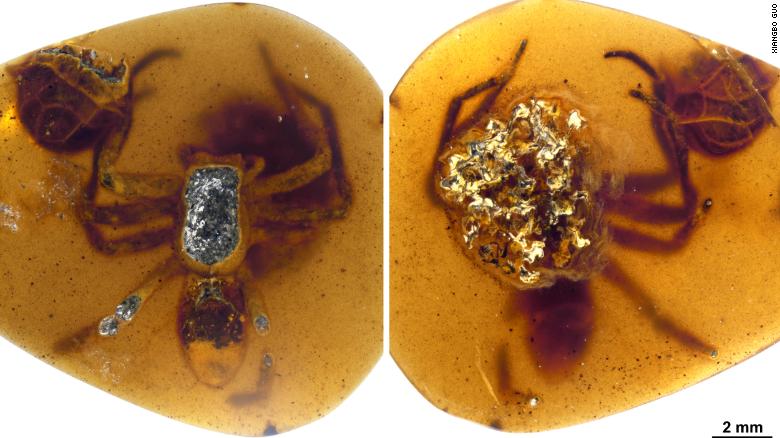
(CNN) – Nothing stands between a fiercely protective spider mother and her young. The resin dripping from the trees trapped the adult female spider and its spiders about 99 million years ago, forever showing maternal care for these arthropods, according to new research.

A female lagonomegopide spider and its sack of eggs were discovered in Burmese amber dating back 99 million years.
The family of spiders Lagonomegopidae is now extinct, but spiders have a long history and first appeared during the Carboniferous period between 359 and 299 million years ago.
The fossilized pieces of Burmese amber tell two different stories. A study detailing the observations of amber samples was published Tuesday in the journal Proceedings of the Royal Society B: Biological Sciences.
One “shows a female lagonomegopide spider grabbing an egg sac containing eggs about to hatch (small pre-chicks can be seen inside the egg sac),” said study author Paul Selden , professor emeritus Gulf-Hedberg at the University of Kansas, in an email. “This is exactly what a living female spider that sits in a crack in the bark of a tree would look like (in this case, just before it was drowned in tree resin).”

This illustration shows a female lagonomegopide spider protecting her egg sac in a Cretaceous forest.
Other pieces of amber show a group of tiny pups that had just been born. This shows that a female lagonomegopide spider protected her egg sac from any harm. Once the cubs hatched, they remained together and were cared for by their mother, as evidenced by the fragments of Lagonomegopidae legs of the same piece of amber.
This suggests that the spider cubs probably stayed close to their mother for a time after birth.
The researchers were pleasantly surprised by “how everything fit wonderfully into place. We had three or more specimens that corroborated the story with each other,” Selden said.
The researchers used computed tomography to detect tiny eyes and other features that revealed the identity of the spider, as well as the tiny pups in 3D.
Lagonomegopidae spiders can be distinguished because they had a pair of large eyes located in the front corners of the head. Other known fossils of these spiders have revealed that they had a reflective mat in their eyes, similar to other nocturnal creatures; think for example of the way a cat’s eyes glow in the dark.
These now extinct spiders resemble modern jumping spiders, but are not related at all.
Spiders are known to exhibit maternal care, but fossilized examples of this are extremely rare.
“While we expected spiders to have maternal instincts from the beginning, it is, however, very good to have real physical evidence from the fossil record from about 100 million years ago,” Selden said.
But what does maternal care really mean, which is observed in many species of living spiders today?
“Parental care refers to any investment by parents that improves the fitness of their offspring and often to a cost to the parents’ future survival and reproduction, ”the researchers wrote in the study. “Their evolution represents a major breakthrough in the adaptation of animals to their environment and has important implications for the evolution of sociability.”
Other arthropods that exhibit this type of care include insects and crustaceans.
Selden and colleagues will continue to look for “other cases of behavior frozen in time.”